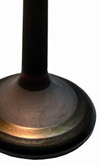Coatings: phosphating
 There are a number of surface treatments which go under the generic term 'phosphating', but not all are used for the same purposes and equally not all will be potentially of use to us as engine designers or in specifying parts which will increase performance or reliability.
There are a number of surface treatments which go under the generic term 'phosphating', but not all are used for the same purposes and equally not all will be potentially of use to us as engine designers or in specifying parts which will increase performance or reliability.
Phosphate is itself not a substance, but a negatively charged ion which may be found in solutions in a number of forms. The form which we might remember from chemistry (if we haven't used selective recall to blank chemistry from our memory) is PO4, which comprises one phosphorous atom and four oxygen atoms surrounding it. It has a charge of 3-, and will therefore combine with three positively charged ions with a charge of 1+, as with hydrogen to form phosphoric acid. Therefore, when we talk of phosphate coatings, we are really talking of a compound involving one or more phosphate ions and a positively charged ion, which in terms of engineering coatings is a metal ion. Zinc, manganese, iron and calcium phosphates are used as engineering coatings for a number of applications, and here we will discuss those that are relevant to engines.
The coatings are conversion coatings, which involve a chemical reaction of the component surface in a solution containing salts of the phosphate compound in question.
Iron Phosphate is widely used as an undercoat or primer for painting and so is unlikely to be extensively used for racing engine components, unless as a pre-treatment for paint where external surfaces need to be protected. An example of a racing application might be a cylinder block on an engine which we don't expect to regularly remove for service.
The combination of oil and zinc phosphate can give a very useful degree of corrosion protection to components, and in this case the phosphate coating is used as an undercoat for oil. As we are aware, oil will run and drip off a component, and so any protection against corrosion is generally temporary and short-lived. Zinc phosphate itself is not a corrosion inhibitor, but its ability to absorb and retain oils is what gives this combination good corrosion inhibiting properties. For racing components it is also used in some circumstances as an undercoat for other surface coatings, including organic and polymeric coatings which might not have sufficient adhesion to the metal on their own. Fasteners are a common application of this finish (see picture).
Manganese Phosphate often used as a surface treatment to aid running-in is quite commonly applied to cam followers and other components for this precise purpose. Pistons are another application of these coatings and a number of suppliers of racing pistons specify these coatings, where they feel that, in addition to improved running-in behaviour, they offer some protection against wear damage at start-up, especially in the piston pin bore and piston ring grooves. Many of the grey-coloured pistons that we see in the cabinets of piston manufacturers at trade shows have this phosphate coating applied. Some companies supplying pistons with coated skirts first apply a phosphate coating to promote adhesion of the skirt coating.
Fig. 1 - A couple of examples of phosphated fasteners.
Written by Wayne Ward